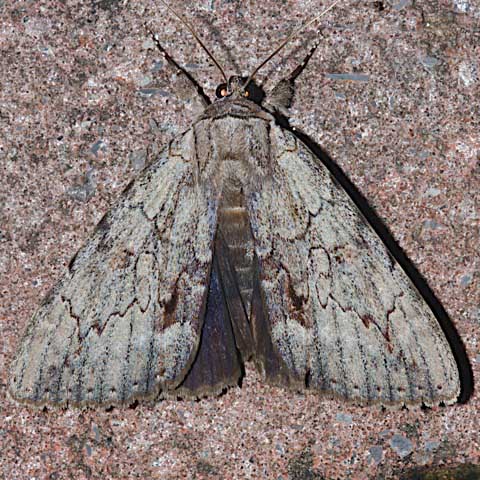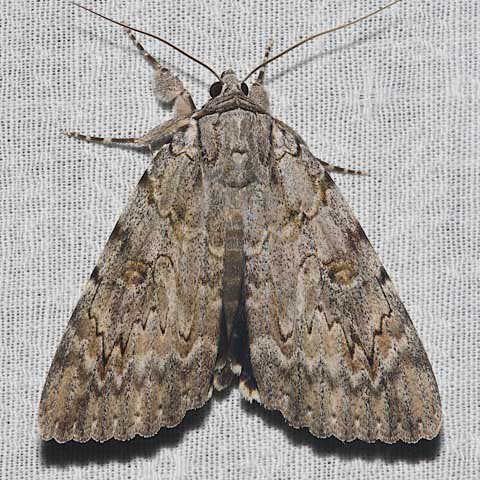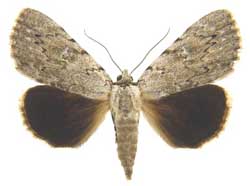
|
orba,
Orba Underwing; 40-45mm; WO?;
The forewing is a uniform grey with light lines and poorly defined spots.
The hindwing underside is completely black. The hindwing fringe is unbroken and slightly off white, somewhat grey.
Note absence of any dark bar in the median-subterminal area, paralleling the inner margin, near anal angle.
|
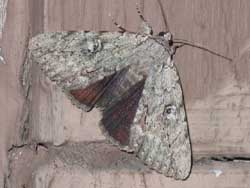
|
judith:
This is one of the smaller "black" underwings. The forewing is a uniform light grey with thin and only slightly darkened antemedial,
median and postmedial lines. There are no darkened dashes
(slight anal dash) or transverse lines. The reniform area is slightly darkened while the area just before the subterminal line is a bit lighter.
|
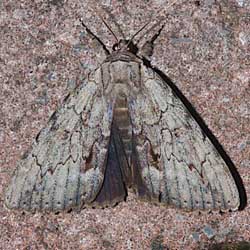
|
catocala #1:
|
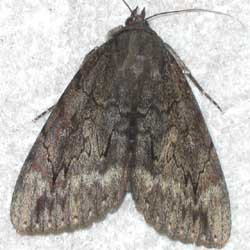
|
residua:
The fw basal, medial and subterminal are concolorous dull grey, interrupted only by a diffuse, dentate, whitish subterminal line, outwardly
highlighted with diffuse, darker scaling. The terminal area tends to be lighter, especially near the apex.
The am and pm lines are thin but complete from costa to inner margin. Subreniform spot is hooked, open, and lighter than
surrounding areas. When only the forewings are visible, the lighter subreniform spot and generally lighter terminal areas
distinguish residua from obscura.
|
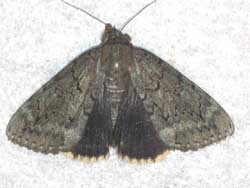
|
obscura:
The fw basal, medial, subterminal, terminal areas are concolorous dull grey, interrupted only by a diffuse, dentate, whitish subterminal line, outwardly
highlighted with diffuse, darker scaling.
The am and pm lines are thin but complete from costa to inner margin. Subreniform spot is hooked, open, concolorous to slightly lighter than
surrounding areas.
|
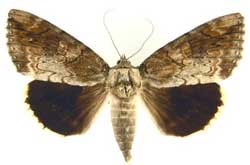
|
Catocala atocala;
Upper half of thin distinct am line runs obliquely toward anal angle, turns making two lobes to im;
basal area darker grey-brown; large light brown reniform and closed subreniform spots; dark upper half median and brown subterminal areas, lighter lower half;
thin, distinct pm line with two elongated upper teeth; almost white along entire im.
|
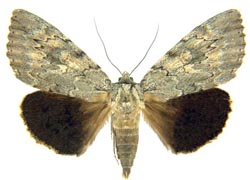
| ** 8780
Catocala robinsoni;
70-80mm.
Fws relatively plain pale grey.
Female has basal dash, absent in male.
Currata French, 1882, female form: weak basal dash.
Rare form missouriensis Schwarz, 1915: dark, broad bar
extending from basal area to o.m. just below
apex. Lighter grey rnfm, subrnfm spots break bar
in missouriensis, found from PA. to FL.
Hw fringe: White; bands on ventral surface prominent.
|
Catocala robinsoni, Tom Payne
Catocala robinsoni, Clay County, August 6, Wayne A. Miller.
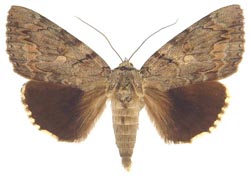
|
Catocala agrippina
75-85mm;
In the male, the fws are grey-black with some
reddish brown (distinguishing characteristic); am and pm lines are black, darker toward costa, much lighter near inner margin.
Reniform is indistinct and brown; sub-reniform is almost obsolete, but lighter than surrounding areas.
Hws are black, with greyish hairs at base and im. Fringe is white, only partly cut with black at
terminations of veins.
|
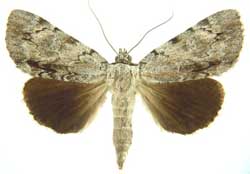
|
miranda,
Miranda Underwing; 37-45mm; WO?/WAM;
Fw is a plain pale grey with very light and fine black lines, darker and wider near the costa. The hindwing is
black with white fringe at the apex, turning to grey along the outer margin.
Miranda is smaller than look-alike orba and miranda also has a dark bar just above the inner margin in
the median area, projecting toward the anal angle.
|
Catocala miranda, Clay County, June 26, Wayne A. Miller.
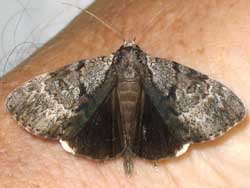
|
andromedae,
Gloomy Underwing; 40-50mm; GSMNP/WAM;
Black hw and dark grey hw fringe,
coupled with dark fw inner margin help to identify
this species. Moths rest with heads
pointing downwards.
There is very dark "flying saucer" shape, adjoining
subreniform spot to midpoint of am line.
The "teeth" of the postmedian line are short and blunt,
outwardly edged with white. The subterminal line is also outwardly edged with white.
|
Catocala andromedae, Clay County, June 23 - July 15, Wayne A. Miller.
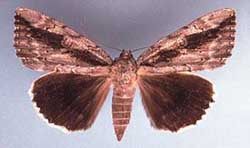
| ** 8782 Catocala flebilis ;
Mournful, 54-65mm; TP/WAM.
Diffuse black band runs from basal area to
outer margin just below apex, interrupted by pale grey
subreniform spot. Reniform spot filled with brown;
additional brown outside pm line. No anal dash
as in angusi. Hws: white fringe. J. K. Adams image.
|
Catocala flebilis, September 20, 2008, Tom Payne.
Catocala flebilis, Clay County, July 5 - August 6, Wayne A. Miller.
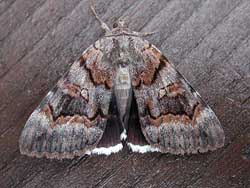
| ** 8773
Catocala epione ;
Epione Underwing, 55-65mm; TP/WAM
The pm line is squared and has a brown band and then a light band
just outside the line. The hindwing is black with pure white fringe
with no barring.
John Himmelman image.
|
Catocala epione, lights, Woodlawn, Montgomery County,
June 29, 2008, Tom Payne
Catocala epione, Clay County, June 21 - August 6, Wayne A. Miller.
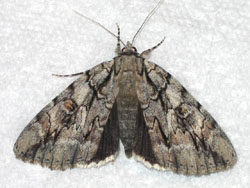
|
Catocala retecta;
wingspan: 60-75mm.
Note light coloured, elongated and open subreniform spot
which interrupts dark, diffuse ark running through center of
wing from basal area (body-wing juncture) to fw
apex. Center of reniform spot brown and there is a brown
area just below costa running to inner margin just outside pm
line. Off-white hindwing fringe only lightly checked along
wing veins.
Joe Garris image.
|
Catocala retecta, Woodlawn, Montgomery County,
August 24, 2008, Tom Payne.
Catocala retecta, Clay County, July 5 - August 6, Wayne A. Miller.
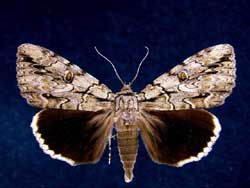
|
Catocala luctuosa;
70mm;; WAM;
Light grey (yellowish tint) fw clearly marked with basal dash continuing with another dash through am line, then another anal dash almost
forming bar parallel to the im.
Hw fringe white & only lightly barred at veins.
The "teeth" in the forewing postmedial line are elongated and dark, continuing a dark dar emanating from the outer margin
just below the apex.
|
Catocala luctuosa, Clay County, July 5 - August 6, Wayne A. Miller.
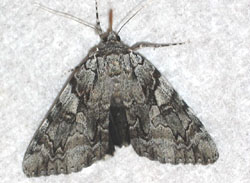
| Catocala dejecta,
56-73mm; Hodge #8790; GSMNP/WAM;
The Dejected Underwing is quite similar to Catocala retecta.
Here the light coloured subreniform spot is also open, but it has a
distinct "pork-chop" shape and separates a much darker median area
below the subreniform spot from a very light area to the costa
above the spot.
The lower quarter of the submarginal area is also
much darker in C. dejecta than in C. retecta.
|
Catocala dejecta, Clay County, June 24 - August 4, Wayne A. Miller.
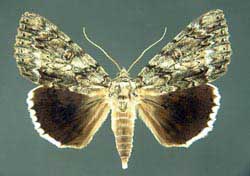
|
ulalume;
Ulalume Underwing; 62-75mm; GSMNP/TP/WAM;
The forewing colouration is a mottled light to dark grey with no strongly contrasting lines, dashes or bars.
At the inner margin the antemedial line ends with in a very light coloured crescent. The subrenifrom spot is also light coloured and "comma" shaped.
The hindwing is black and the fringe is pure white with thin, sharp (pointed) checking.
|
Catocala ulalume, lights, Woodlawn, Montgomery County, July 18, 2008, Tom Payne.
Catocala ulalume, Clay County, July 31 - August 4, Wayne A. Miller.
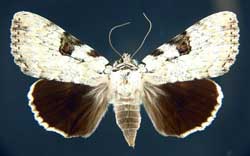
|
Catocala sappho;
Sappho Underwing; 60-75mm; TP/WAM;
Forewings are off white with some grey-black-brown peppering and yellow-beige lines.
The reniform spot is brown and the subreniform spot is almost pure white; the hindwings are black with a white fringe.
|
Catocala sappho, lights, Woodlawn, Montgomery County, July 26, 2008, Tom Payne
Catocala sappho, Clay County, August 4 - August 6, Wayne A. Miller.
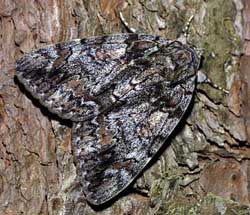
| ** 8794
Catocala lacrymosa;
Tearful Underwing, 60-82mm;; GSMNP/TP/WAM;
The forewing is highly variable with a mixture of black, brown
(wing tips and outside postmedial line) and dark grey scaling.
There are usually whitish crescents, along the inner margin at the
base of the antemedial and postmedial lines.
The hindwings are black with white checkered fringe, turning black
near the anal angle. There are several different forms.
|
Catocala lacrymosa, lights, form paulina, Woodlawn, Montgomery County,
August 26, 2008, Tom Payne.
Catocala lacrymosa, lights, form evelina, Woodlawn, Montgomery County,
September 2, 2008, Tom Payne.
Catocala lacrymosa, bait, Woodlawn, Montgomery County,
August 20, 2008, Tom Payne.
Catocala lacrymosa, September 21, 2008, Tom Payne.
Catocala lacrymosa, Clay County, July 16 - August 5, Wayne A. Miller.
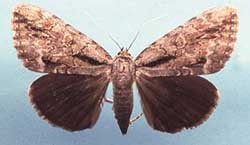
| ** 8783 Catocala angusi
WO; Angus' Underwing, 60-74mm; WO?/WAMDark dashes/streaks in basal area and anal area distinguish
this species. Reniform spot tends to have a light brown filling.
Hw fringe is black except for white region at apex.
Form lucetta has broad black band from basal area to
om, broken only by reniform and subreniform spots.
James K. Adams image.
|
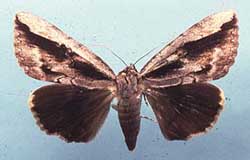
| ** 8783 Catocala angusi
WO; Angus' Underwing, 60-74mm; Dark dashes/streaks in basal & anal areas. Reniform spot: light brown filling.
Hw fringe black except for white region at apex.
Form lucetta has broad black band from basal area to
om, broken only by reniform & subreniform spots.
James K. Adams image.
|
Catocala angusi, Clay County, July 31 - August 6, Wayne A. Miller.
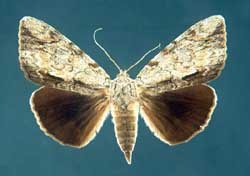
| ** 8791
Catocala insolabilis;
Inconsolable, wingspan: 65-75mm; WO?/WAM;
The forewing is light grey with blackish shading along the inner
margin. The antemedial and postmedial lines are thin.
The hindwing fringe is very narrow and grey, becoming whiter toward
the apex.
The ventral surface clearly distinguishes insolabis, being almost
completely black except for some white in the basal area.
Vernon A. Brou image.
|
Catocala insolabilis, Clay County, July 4 - August 3, Wayne A. Miller.
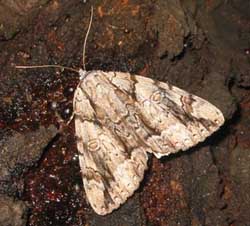
| ** 8792
Catocala vidua;
Widow; 70-80mm.
Fw ground colour light grey.
Distinguishing dark arc runs through top of reniform spot
to just below apex. Heavy, dark anal and basal
dashes, connecting to dark median bar, running parallel to i. m.
Am line thick, black in its upper half.
Reniform spot with two almost
concentric irregular ovals.
Subreniform spot light, open, constricted as it
meets pm line.
Hw black with broad, white fringe, lightly
interrupted.
Marie Winn image. |
Catocala vidua, Woodlawn, Montgomery Co.,
Aug. 10, 07; Sept. 21, 08, Tom Payne.
Catocala vidua, Clay County, August 1- August 6, Wayne A. Miller.
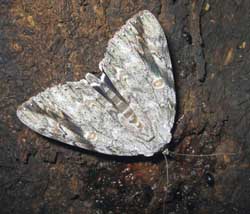
| ** 8793
Catocala maestosa
Sad Underwing, 78-98mm; WO?/WAM;
Maesotsa is quite similar to, although usually larger than, vidua.
Both have the dark arc from the costa, above the reniform spot, to
the outer margin just below the apex. Maesotsa, however, lacks the
dark bar, found on vidua, parallel to the inner margin.
The reniform spot is brown and there is brown shading just outside
the postmedial line.
The hindwing fringe is white, narrow and heavily barred.
|
Use your browser "Back" button to return to the previous page.
Enjoy some of nature's wonderments, giant silk moth cocoons.
These cocoons are for sale winter and fall. Beautiful Saturniidae moths will emerge the following spring and summer.
Read Actias luna rearing article.
Additional online help available. Eggs of many North American Saturniidae species are offered during the spring and summer. Occasionally
summer Actias luna and summer Antheraea polyphemus cocoons are available. Shipping to US destinations is done
from within the US.
This page is brought to you by
Bill Oehlke and the
WLSS. Pages are on space rented from Bizland. If you would like
to become a "Patron of the Catocala Site", contact Bill.
Please send sightings/images to Bill. I will do my best to respond to
requests for identification help.

Click on the flashing butterfly to show
appreciation for this site
and to visit other insect related
sites. |

|
Tennessee Catocala Report
|
